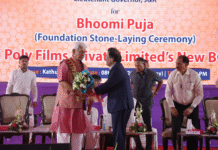Chiripal Poly Films, one of India’s leading packaging film manufacturers headquartered in Gujarat, has formally commissioned its new state-of-the-art factory, which is part of its Rs 1,000-crore mega investment drive, in Hyderabad.
The Hyderabad plant, spread across 35 acres, was inaugurated by Telangana’s minister of education Sabitha Indra Reddy on 12 January 2023 in the presence of government dignitaries, board members of the Chiripal Group, CEO of Chiripal Poly Films, customers, business and banking partners, and employees.
The plant has been adding new machines at regular intervals. At present, the plant has a 10.4-meter BOPP line from Brückner, an 8.7-meter BOPET Dornier line, a 5-meter CPP Colines line, and four metallizers (1x 3650mm width, 2x 2850mm width and 1x 2450mm width). The BOPP line was commissioned earlier this year, the BOPET line was started in 2022, and the CPP line will be commissioned in March this year.

“We have invested Rs 1,000 crore in this expansion phase, which includes the plant and the machinery. We chose Hyderabad because we wanted to expand our geographical footprint beyond Gujarat. Hyderabad has a number of flexible packaging convertors, who are our customers. Hyderabad’s good infrastructure and investment climate are an added advantage,” says the company’s CEO Sumant Singhal.
The plant is a major milestone for the company that entered the film manufacturing business a decade ago. Establishing itself as a serious player in the industry within a decade, Chiripal Poly Films is now a major player in the packaging films business and clocks a turnover of Rs 4,000 crore. Over the last decade, Chiripal Poly Films has grown to become a multi-line, multi-product, and multi-location company.
Chiripal began manufacturing BOPET with a single line in 2015 – its second product after BOPP. It entered the PET resin space in 2017, marking its diversification to packaging feedstock beyond films. In 2019, it started its coating line, which was a significant step towards strengthening its value-added products portfolio. The new plant in Hyderabad began operations in 2021.
With the formal commissioning of the Hyderabad plant, the plant’s combined film manufacturing capacity stands at 118,000 tons per annum. Chiripal Poly Films’ overall film manufacturing capacity now stands at 233,000 tons per annum. The company’s PET resin manufacturing capacity is 220,000 tons per annum apart from the downstream value addition capacities of metallizing and offline coating.
Strong faith in Indian flexible packaging
Despite current high inflation and high-interest rates, Chiripal Poly Films remains extremely bullish about the growth of the Indian flexible packaging industry. “We are very optimistic about the Indian flexible packaging industry’s growth, which is underpinned by a growing population, rising income, and overall economic growth. Yes, we face some headwinds in the short term such as high raw material costs that may impact our margins. But overall, the trend remains intact. If you remember, a global economic recession in 2008-2009 affected the Indian flexible packaging industry in the short term. But look at the industry’s growth since then. Hence, from a five to ten-year horizon, I am very bullish and that is why we are investing,” Singhal explains.
Chiripal Poly Films will continue to invest and expand in the BOPET, BOPP, and PET resins segments, he said. It will also diversify to aluminum foil. Singhal said that due to its growth potential, the Indian flexible packaging industry will see more mergers and acquisitions and attract foreign players and investors.
“In the recent past, a number of foreign companies and PE players have invested in Indian film manufacturers and convertors. This trend will strengthen going forward. This is good for the industry. We at Chiripal Poly Films are open to strategic partnerships,” Singhal says.
Reusability and recyclability
Singhal believes the flexible packaging industry needs to focus on reusability and recyclability in order to tackle the problem of plastic packaging waste, and effectively manage waste at the plant level. “At our Ahmedabad and Hyderabad plants, we manage our waste very effectively. Both of them are treated discharge plants. Whatever waste we generate at the plants is reused in-house or converted into pellets and sold to third parties. All waste is recycled and reused in some form,” he says.











